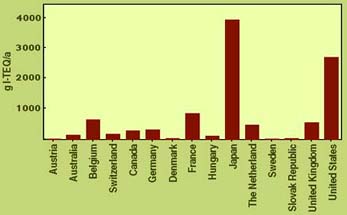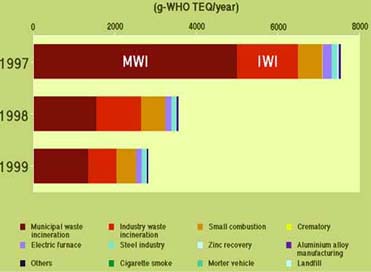| |
|
Japan Offspring Fund International Project
Dioxin Contamination of Ashes in the Asia-Pacific Region (2000) | Introduction | Objectives/Samples | Results | Conclusion |
In 1977, Olie and others reported that fly ashes from waste incinerators contain Dioxins*2. Since then, various studies showed that incinerators are one of the biggest sources of Dioxin contamination. Situations in Japan This figure (figure1) shows each country's fluxes of Dioxins in 1995. In Japan, it was reported in 1985 that fly ashes of incinerators are contaminated with Dioxins*3. Though the government did not take appropriate actions. And due to this delay of the government actions, the output of Dioxins in Japan became the highest in the world in 1995. Figure 1 Dioxin Fluxes of Countries (1999 UNEP) This figure (figure2) shows the emission inventory of Dioxins from 1997 to 1999. In Japan, the government is trying to reduce the output and its goal is to reduce the output to 10% of 1997 before the year 2002. As you can see in this figure, the output has decreased in these three years. However, still, the output is very high, so there should be more improvements. Figure 2 Emission Inventory of Dioxins in Japan (2000 Ministry of Environment)
It is also obvious that the waste incinerators are the biggest sources of Dioxins. However, in this figure, the amount of ashes is not counted. Various studies show that Dioxins existing in the air are decreasing. Though it is important to focus on the fact that Dioxins which are not released into the air remains in ashes. Situations in Other Countries The emission inventories of Dioxins are made in many countries. Though they are mainly done in developed countries. Information and researches about Dioxins in developing countries are still insufficient and we thought that testing ashes of such countries would help us all.
| Introduction | Objectives/Samples
| Results | Conclusion
|
|
||||||||||||||||||||||||||||||||||||||||
|
Copyright(C) 2004 Japan Offspring Fund, All Rights Reserved. Tel:048-851-1212 Fax:048-851-1214 Mail: Please give me the subject name in Japanese. |


